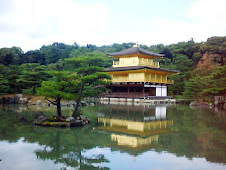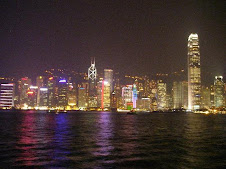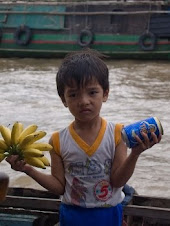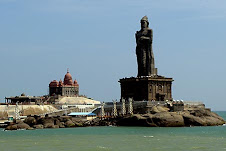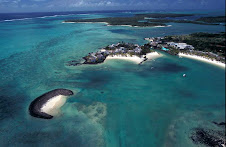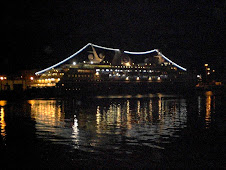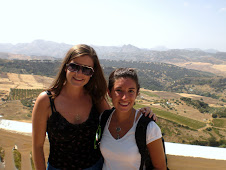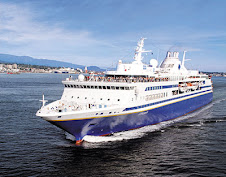Hello from just outside of Singapore! Unfortunately we’re only refueling here with the very impressive city skyline in the distance. We can’t even get off of the ship for the day—I guess we’re on a tight schedule trying to make our way through the Strait of Malacca and over to Vietnam. Next time though, I’ve decided that I have to make another around-the-world trip at some point in my life to get to the places we’re missing. Maybe Latin America, then South America, through the Mediterranean and Red Sea, hit a little more of Africa on the way to Indonesia, Australia, New Zealand, and the rest of Oceania. Wishful thinking, I know.
It’s been a few days since India now so I’ve had some time to really think about everything that I saw—it definitely took some reflection because it was the most ‘intense’ experience yet. Between the unbelievable amount of pollution, the severe discrepancies in wealth, and the extreme culture shock I have so much to write to you all about, but I’ll try to keep it relatively concise.
First of all, I would like to say that India was absolutely amazing. I was quite worried about what I would experience prior to arrival in Chennai because our ship psychologist and deans were all forewarning us about what we were going to see and telling us of ways to relieve our stress if we were overwhelmed by the country. They must have forgotten about all of the poverty we have already encountered in places like Morocco, Ghana, and South Africa because India was not as intimidating as I was expecting. I must say though, out of everywhere we’ve been, India’s list of endemic diseases was by far the most extensive. I’m not one who is normally OCD about sanitizing my hands every fifteen minutes, but India and its cholera, polio, meningitis, typhoid, dengue fever, malaria, measles, etc. definitely worried me and had me thinking about every surface that I touched and food that I ate. By some miracle I made it out of there without any health repercussions [other than the loss of a week or two off of my life due to the huge amount of particulate matter that I inhaled].
The vast presence of pollution was truly shocking. Though in total the United States pollutes more than India, the United States seems like an untouched paradise next to ash and trash ridden India. Every night I would blow my nose after returning from my travels—not to be overly graphic, but my snot really did consist of tiny black particles. When looking in the mirror I could literally see this same black dust all over my face. Another major environmental problem that India faces is its wastewater and sewage treatment, or lack thereof. You may think this would be hard to notice just touring around, but there was a very distinct stench that came about as soon as we got within two hundred yards of the river that runs through Chennai. Lastly, there’s the overwhelming presence of trash. There really aren’t garbage cans anywhere on the streets because the streets are the trash cans.
My sleeper train ride down to the southern-most point of India really epitomizes the Indian attitude towards waste disposal. Before I say more, let me tell you that the sleeper train was a whole experience in itself. We were packed into train cars like the crew of a nuclear submarine. The bunks went three high and were immediately next to one another. Even with this and the several cockroaches my friends and I spotted it was an awesome experience. We chatted with some Indians about everything from the caste system to arranged marriages and the history of Hinduism. We saw the beautiful countryside of India and ate crazy Indian food off of banana leaves and with our hands (as is customary in India). I slept within arms distance of four very cool professors that were taking the trip with four of us students. So very cool, very India-like experience, but out of all of it the most surprising aspect was what happened to the waste produced on the train.
My first trip to the bathroom on the train was the first time I encountered an “Indian-style” toilet, which is a toilet where you just sort of squat to use the restroom. If that wasn’t alarming enough, I realized that the waste literally dropped out of the train car and onto the tracks. I could see the light reflecting off of the tracks up into this bathroom through the “Indian-style” toilet—very, very strange. It wasn’t for a while, until we were about to get off of the train after the fourteen hour ride, that I realized what was happening to our trash. Someone had always offered to take my trash for me so I didn’t think anything of it. I thought they brought it to waste bins at the end of the train, but when staring out the window looking at the extensive banana plantations I suddenly realized where that kind woman was taking my empty chips bag and water bottle. She had taken them to the train car door and just thrown it out the side as everyone did—as was expected, because there weren’t even any waste bins on the train. There is a wholly different mentality on waste in India, one that is going to have to change as India’s dense population continues to grow.
Anyway, the sleeper train I rode with the eight others took us from Chennai down to Nagercoil, which is at the very bottom of the nation near Sri Lanka. We were told that the trip was a sort of town visit, so we were quite surprised when we found out that Nagercoil is a “town” of four hundred thousand people. I guess by Indian standards that’s hardly a large enough population for a “city.” On this trip we were guests at a wonderful Indian couple’s large home. Latha and Kumar are very wealthy Indians who spent fifteen years in the United States when Kumar was working as a software engineer. They returned to India to take over the family businesses which include a rubber plantation, a spinning mill, a hotel, a school, and a university. They employ over a thousand people in Nagercoil and clearly are an exception to the majority of Indians who live on two dollars a day. With fifty inch Samsung flat screens around the house and servants who literally run to pick up your empty soda can, Latha and Kumar acknowledged that they had made the decision to be very wealthy Indians rather than middle class Americans.
Kumar and Latha were amazing hosts. We ate enormous, delicious Indian meals everyday and they took us to see everything to be seen in the area. We made trips to a very old palace and a number of temples, including one gigantic stunning temple, named Suchindram Temple, that had been built in 700 AD. I didn’t know that people could build such structures then—it was over one hundred feet high and the entire outside was made of these intricate statues that told stories. We got to go inside the temple at night when everyone was worshiping. No shoes were allowed to be worn in the temple and the guys had to take off their shirts—not exactly the “no shoes, no shirt, no service” policy we’re used to in the States. Inside of the temple we got to light candles and offer flowers and butter to the statues of Hindu gods like Ganesha (my favorite, the elephant and god of luck). It was an extremely cool, surreal experience.
Kumar and Latha also took us down to the very bottom coast of India, a place called Kanyakumari. At Kanyakumari, the “three seas” meet—the Arabic Sea, the Indian Ocean, and the Bay of Bengal become one. Though it’s purely a geological phenomenon and not really different seas meeting, you can see waves that clearly hit the rocks on the coast from the three different directions. Kanyakumari is of religious significance to Hindus as well so there is an enormous thirteen story statue of one of the gods right off of the shore.
One of the best parts about being with Kumar and Latha was that we didn’t really do touristy things. The places we went to were busy, but with Indians and not foreigners. I saw two other white people at the huge temple, but other than that we were the only Caucasians around during our travels in Nagercoil. We were so unique that more than a few Indians took pictures of us as we were just walking around. Occasionally we were even asked to pose. (Later in the trip I was cleaning as part of a service project and was asked by an Indian to pose with the duster for his picture. I’m not sure if he thought it was funny that white people cleaned, but I didn’t care so I put on a nice smile.)
Without elegantly integrating the following stories into my blog, I want to share what I thought were two funny little experiences in India. First, I was on a bus putting on sunblock on my face when I offered some to my friend; a woman who we had been talking with asked us if we were just putting lotion on our faces. Though she was a relatively well off, educated woman, she didn’t know what sunblock was. Secondly, I was out eating with some of my friends when we asked a man who worked at the restaurant to take a picture of us. He held up the camera with the lens pointing at his eye, thinking it was a viewfinder and not realizing that there was a screen on the other side on which the digital image is displayed. Particularly in India, there were so many of these seemingly very minor experiences that really took me aback and changed my assumptions of what is widespread knowledge and practice.
After returning to Chennai, I spent my last day in India on a service visit to an institution that houses adults with physical and mental disabilities, rehabilitates those with orthopedic problems, and schools children with a wide range of disabilities. At this establishment we first helped by cleaning a filthy room in which about twenty of the physically disabled women live. Prior to that experience I didn’t know that so much dust could collect in such a heavily lived in room. After cleaning we were able to go around to see and hang out with many of the people there, which was really the reward for our help.
It was pretty shocking to encounter individuals who have been affected by polio—definitely not an experience that I imagined I would have in my lifetime. I know this sounds corny, but I think it was the first time I could fully appreciate modern medicine. Without what we Westerners assume as commonplace medicine I would of had childhood nightmares of disease instead of nightmares about robbers. It was pretty unbelievable to see how a virus can cripple a human body. The doctor walked us from patient to patient telling us of each person’s disease and treatment (clearly, Indians don’t share our sentiments on medical confidentiality).
One woman we saw was exactly my age, twenty, and had suffered from polio when she was a young child. The doctor told us that last year her family had finally saved up enough money to pay for a remedial surgery, and after it she was able to walk for the first time in her life. The woman understood what the doctor had told us in English and had a huge smile on her face. The single moment when that woman smiled with such great satisfaction, and looked at me searching for excitement in my expression, struck me more than any other experience I’ve had on this trip.
After seeing patients we got to go play with the school children in the institution. The classroom I visited had the most precious little Indian children with hearing disabilities. The children were taught some sign language and with hearing aides most of them could hear and speak some. Still, none of them spoke English so we had to find other means of communication. In an attempt to bridge the language gap a friend and I decided to play “Miss Mary Mac” and “ring-around-the-rosy” with the kids. All was well until the kids started really getting into the falling part of ring-around-the-rosy and hearing aids begun flying everywhere. Though I nervously looked to the teachers when this happened, neither they nor the children were fazed; the kids simply put their hearing aids back in and were ready to go for another round.
Despite the great amount of poverty and disease pervasive throughout India, there seems to be hope for the world’s second largest nation. India has had high and relatively consistent economic growth over the past decade or two. The people I spoke with said they’ve seen clear improvements in the average quality of life. The doctor who gave us the tour of the rehabilitation center, said that his young patients are now mainly children with cerebral palsy as polio has been eradicated in the southern part of India. Without overlooking the suffering I did my best to remain hopeful thinking of improvements India has made and of those soon to come. Still, I hope through its development and industrialization India will not lose any of its rich culture, because I think India is by far one of the most unique places on earth.
Well now we’re moving on from the world’s largest democracy to one of the few surviving communist countries—the first communist country I will ever visit! I am extremely excited for tomorrow morning’s arrival in Ho Chi Minh, Vietnam. Formerly known as Saigon, the city was renamed “Ho Chi Minh City” for the communist revolutionary whom our inter-port student told us the Vietnamese worship like a god. I am curious to see if there will be many noticeable differences in a country run under a political system so different from the type we to which we are accustomed.
After exploring Vietnam we are going to have only two days aboard the ship before reaching Hong Kong, but I’ll do my best to blog all about communism and rice paddies before my arrival in China.
I’m sorry, I know I said that I’d try to keep this brief, but I had so many amazing and astonishing experiences in India that I really wanted to share. Your time spent reading my mini-novels is appreciated!
I miss you all, but I am not quite ready to come home and see you yet. Three more countries and sadly only six more weeks!
svc
Tuesday, November 3, 2009
Subscribe to:
Comments (Atom)
